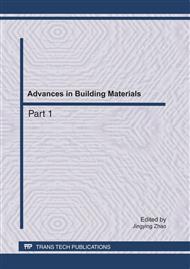p.765
p.770
p.775
p.783
p.788
p.796
p.801
p.807
p.812
Adiabatic Temperature Rise of Condensed Silica Fume (CSF) Concrete
Abstract:
Condensed silica fume (CSF) is often added into concrete mixes to enhance the properties of concrete. However, the effect of CSF on the heat evolution and temperature rise of concrete is not clearly known. Test results in the literature are insufficient and sometimes contradictory to enable any conclusion to be drawn regarding the role of CSF in heat generation behaviour of concrete. Moreover, since the chemical reactions of cement and CSF both involve water and hence cement and CSF are competing with each other in reacting with water, the water to binder (W/B) ratio may affect the temperature rise characteristics of concrete. This paper reports an experimental study of adiabatic temperature rise of CSF concrete conducted at The University of Hong Kong. Five concrete mixes without CSF and 10 concrete mixes with CSF dosages at 5% and 10% were tested with the recently developed semi-adiabatic curing test method. The adiabatic temperature rise was obtained by applying heat loss compensation to the test results. It was found that the addition of CSF could suppress the adiabatic temperature rise of concrete. At the same time, the strength of concrete could be enhanced. Based on the experimental results, prediction formula and design chart of adiabatic temperature rise of CSF concrete were developed.
Info:
Periodical:
Pages:
788-795
Citation:
Online since:
May 2011
Authors:
Price:
Сopyright:
© 2011 Trans Tech Publications Ltd. All Rights Reserved
Share:
Citation:


